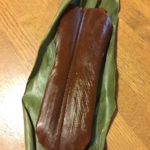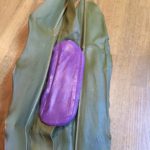Muuchii ムーチー (鬼餅) is Okinawa’s version of Japanese mochi もち (餅). It is made with glutinous rice flour, however that is seemingly where the similarities end. Muuchii is fairly simple to make and the ingredients can easily be found in the grocery.
*you may see muuchii also spelled as: muchi or muuchi in Roman characters.
The muuchii is prepared with the desired flavor and shaped into rectangle-ish shapes, placed in the center of the shell ginger leaf (sannin サンニン, 月桃 in Okinawan). Sannin is used because it is believed to have anti-bacterial and healing properties. It is then wrapped like a little package and tied, then steamed for a few minutes. So ono!
It is sometimes called カーサムーチー caasa muuchii; カーサ caasa refers to “leaves” as in the sannin leaves used to wrap the muuchii.
There are many different flavors that are used. One is Okinawan brown sugar 黒糖 “kokutou.” Another popular flavor is purple sweet potato, beniimo 紅芋. I have also made taro flavor; this has many names (I probably need an entire post on this). Tanmu ターンム or taamu ターム in Okinawan (dependent on location, as Okinawa language has many variations), and taimo 田芋 in Japanese. You can also find plain flavors (these are often labeled as 白 white or 赤 red/pink), as well as yomogi よもぎ (mugwort), ninjin 人参 (carrot), and kabocha かぼちゃ (pumpkin).
**Muuchii-no-hi ムーチーの日 is on 12/8 of the lunar calendar; this date is very important to Okinawans. Especially those that have a new baby in the family– they are supposed to make and distribute muuchii to everyone they know! Those with children hang up on a long string in the house the number of muuchii for every year of age, 1 strand for each child. It is eaten as a lucky charm for the prayer of health and longevity.
**muuchii-biisa ムーチービーサ is a saying that it is “muuchii-cold” outside. This means it is so cold, one must eat muuchii (very filling and takes a long time to digest) in order to preserve their stamina!
Part 2 is continued in a new post: Muuchii ムーチー: Folklore and Recipe



3 thoughts on “Muuchii: ムーチー”
Comments are closed.